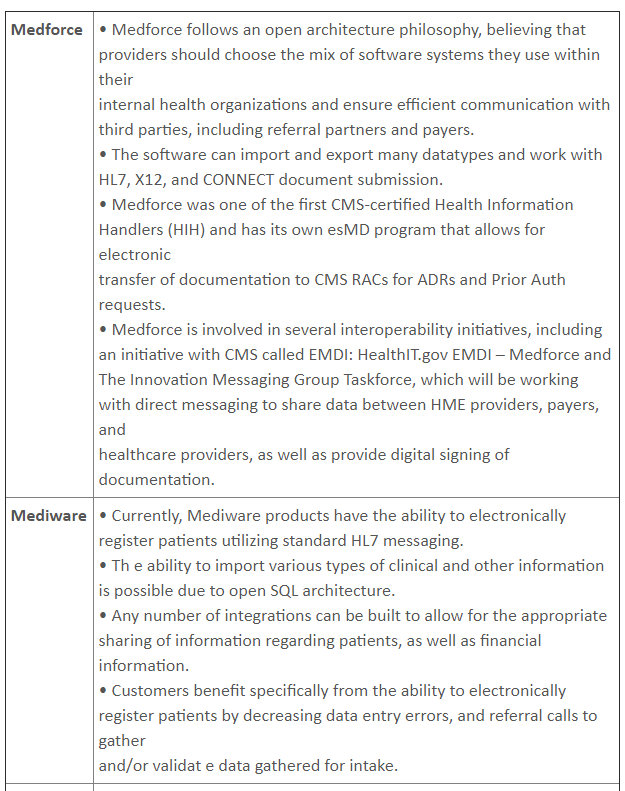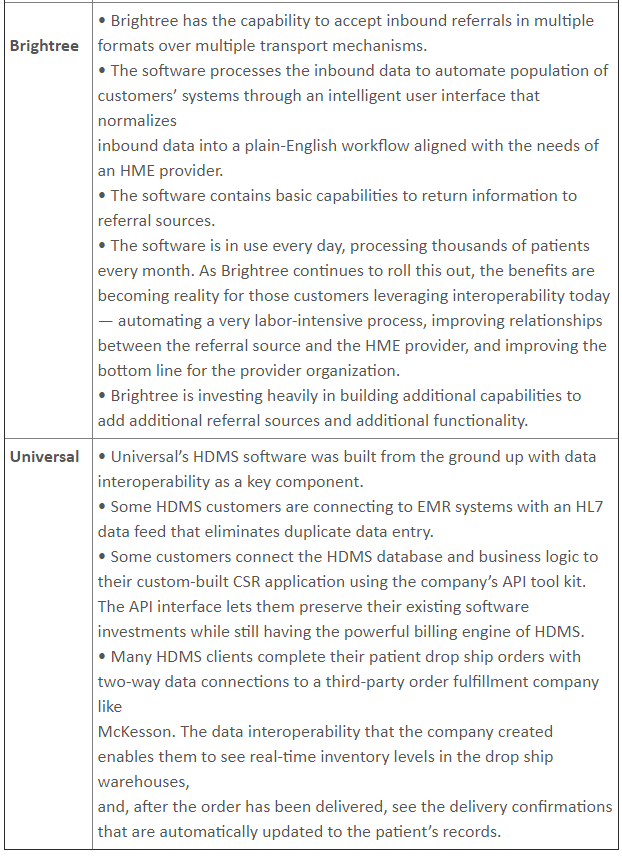HME software companies are helping providers to increasingly enjoy the benefits of healthcare interoperability.
Category: News
SOFTWARE INTEROPERABILITY'S INROADS IN HME
By Joseph Duffy
Originally published on Aug 01, 2017

Healthcare interoperability — the ability of different information technology systems and software applications to communicate, exchange data and use the information that has been exchanged — has been a general healthcare practice for many years. For the HME industry, interoperability is a fairly new development, but according to Nick Knowlton, vice president of business development for Brightree LLC, the HME industry is catching up.
“Tremendous progress has been made the past few years with regard to interoperability in the HME segment of the healthcare market,” he says. “We are still in the early stages of referral management with physician practices and hospitals, but there are many examples of vendors and providers working together to automate clinical information moving to and from HME providers using their software systems.
“We are now working with some of the largest [Electronic Healthcare Record] vendors in the country to automate the transmission of patient information at the time an HME order is placed,” he continues. “The physicians are working in their native workflows and this was unheard of just a few years ago. This will become expected functionality in HME software over the next few years. Additionally, great progress has been made to connect HME providers in other areas, such as patient compliance, patient resupply, delivery notifications and outcomes.”
Part of the progress stems from the HME industry beginning to recognize the need for interoperability in various areas, such as compliance data being accessible in an electronic format, says Kimberly Commito, director of product management for Mediware Information Systems.
“The need for CPAP compliance data to support proper and timely reimbursement is imperative,” she says. “Many software platforms now offer integration with devices that can easily download this data and even trigger billing events to streamline the reimbursement process for charges related to this type of therapy. In addition, referral data that is standard, such as demographics and medical information, can be easily accessed electronically in a number of ways and again, many software platforms now offer the ability to connect systems that are collecting this type of information for
patients, such that duplicate data entry is no longer necessary.”
According to Nathan Apter, CTO of Medforce Technologies, interoperability is moving from being a trendy buzz word to being part of the everyday lexicon of HME providers.
“The idea of software integration is not new,” he says. “But things are changing in two big ways: One is that the baseline level of expectation from HME providers about how their data comes into and moves throughout their organization has risen. Providers are better informed, and this pushes software developers to keep up and continue to create tools that are flexible and can adapt to meet evolving needs. The second way is that talks of interoperability have expanded to be about data transfer and secure sharing of information across healthcare sectors and across players. It is no longer just about the sharing of data between two HME software applications — it’s about creating an entire ecosystem of secure data transfer that is streamlined, automated, and improving the productivity of every entity involved. This includes acute to post-acute, provider to payer, payer to provider — everyone.”
BENEFITS OF INTEROPERABILITY
“Interoperability supports two key factors in the management of the patient,” Commito says. “One, it ensures accurate data is passed between systems, lowering the incidence of errors in the keying of critical demographic and clinical information that can impact patient care if not correct, as well as slow down reimbursement.
“In addition, interoperability can increase both patient and partner satisfaction by decreasing the number of phone calls required to gather critical information throughout patient care,” she adds. “Secondly, interoperability increases patient safety. If compliance and other clinical data can be collected in a timely and accurate manner, the patient can be monitored more effectively and adjustments to care to increase positive outcomes can be accomplished.”
Knowlton says interoperability can improve reimbursement for HME providers.
“With shrinking margins in the industry, sound financial management is increasingly important,” he says. “I know an HME provider who ships 80 percent of their oxygen concentrators before knowing if the orders will be reimbursed. By receiving the data into their system at the time they receive the order, they have the power to address problems before they impact the HME bottom line and can begin the billing process several days before they would in an unconnected environment.”
In addition, Knowlton says that interoperability improves operational efficiency by automating referral and order input and improves alignment with referral sources and with government mandates.
Phil Deschaine, marketing director for Universal Software Solutions, says, “Software IT interoperability is essential to HME providers because it adds remarkable efficiency, reduces costs, and makes providers more responsive. For example some of Universal Software Solution’s HDMS users connect to hospital EMR systems via a HL7 data feed. With this data interoperability in place, as soon as the patient is released from the hospital, their record is automatically created in HDMS. So when patients or their families calls for oxygen, a hospital bed or supplies, all the critical information has been shared from the EMR system and patients can be served more quickly and then be on their way home sooner to recover.”
THE FUTURE OF INTEROPERABILITY
The CommonWell Health Alliance is a member-based organization that believes that “health information technology must be inherently interoperable in order to work.” Their mission is to create and execute a vendorneutral platform that breaks down the technological and process barriers inhibiting effective health data exchange.
Brightree is a member of CommonWell and Knowlton is a co-founder.
“CommonWell is now a fully functional, national network that is growing every day – both in terms of provider sites on the network and interoperability problems that the network is solving,” says Knowlton. “CommonWell is now live at more than 5,000 hospital and physician practice provider sites nationwide, has more than 50 million patient records represented by those sites, and has processed almost 100 million queries to date. Additionally, with the December 2016 announcement between CommonWell and Carequality, the ability to enable healthcare information to follow the patient will grow dramatically in the near future.”
Knowlton also says that the experience of being part of the Alliance has been positive.
“I was personally involved in co-founding CommonWell in early 2013,” he says. “In 2014, before I joined the Brightree team, I received a phone call from Brightree inquiring if the Alliance would be an appropriate venue for advocating for the needs of the post-acute care provider, and if the network services would be applicable to post-acute use cases. That initial inquiry led me to join Brightree a few months later. We have found a very collegial and receptive atmosphere amongst the other vendors to not just listen to understand the needs of an HME provider, but to join together and develop solutions which will be accessible through our software for the benefit of patients and providers. We look forward to deploying those services in the near future.”
INDUSTRY INTEROPERABILITY
The experts interviewed for this article all represent HME software companies that tout interoperability solutions. Here they describe how their software is helping the HME industry reap the benefits of a well-connected healthcare IT infrastructure.



To learn more or request a demonstration of what Medforce software can do for you fill in this form or call our sales department at:
Even our demos let you preview without leaving your desk. View the power of Medforce right from the comfort of your office.